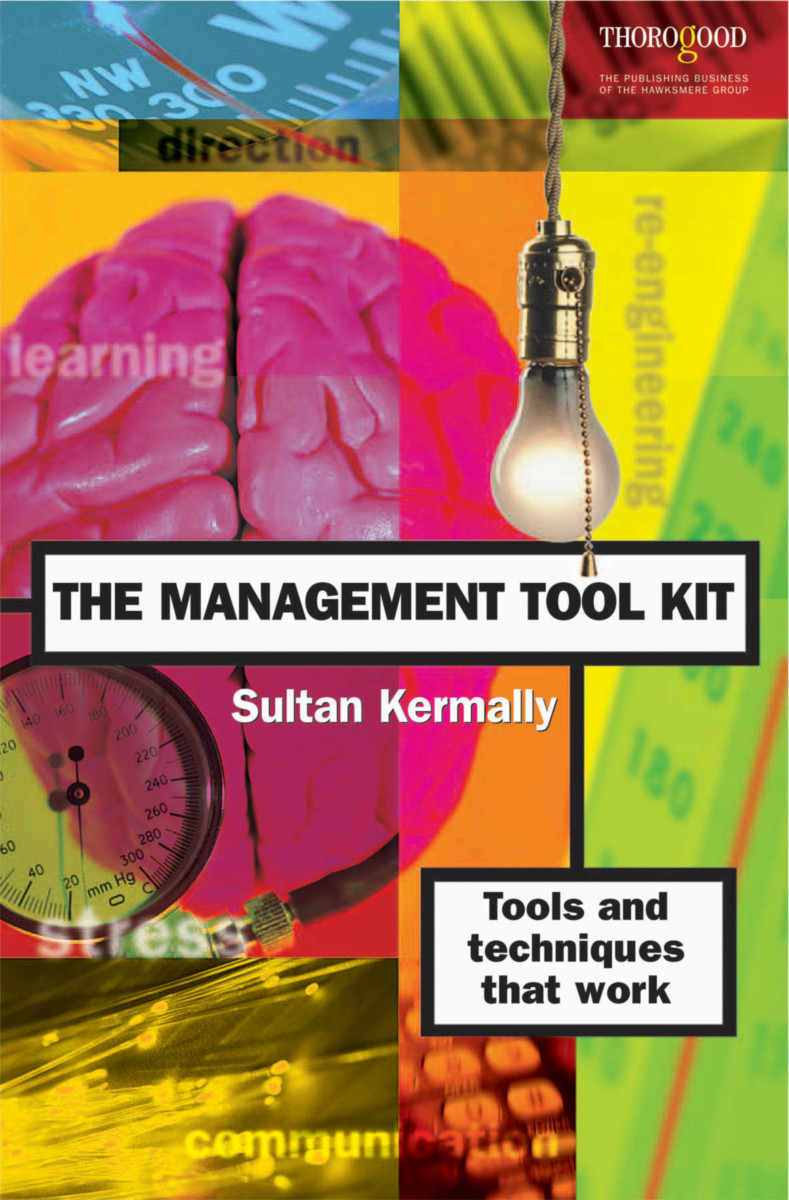BUSINESS BOOKS AND REPORTS
The Management Tool Kit
Tools and Techniques that Work
- Publisher
THO - Published
30th April 1999 - ISBN 9781854181725
- Language English
- Pages 224 pp.
- Size 6.25" x 9.25"
This unique book brings together the 47 most valuable management theories and tools in one volume, in order to help managers perform their functions quickly and effectively. A variety of different tools provide frameworks to structure your thinking and guidance in all areas of management.
ABOUT THE AUTHOR
INTRODUCTION
Plan of the book
CHAPTER ONE: STRATEGY
Tool box 1: What should a mission statement contain?
Tool box 2: Deciding on business direction
Tool box 3: Criteria for setting strategic objectives
Analysis tool: Stakeholders’ analysis
Levels of strategy
Analysis tool: Environmental analysis
Tool box 4: Conducting environmental analysis
Tool box 5: Conducting impact analysis of S.T.E.P. factors
Analysis tool: Industry analysis
Tool box 6: Conducting industry analysis
Tool box 7: Conducting S.W.O.T analysis
Analysis tool: S.W.O.T
CHAPTER TWO: STRATEGY EVALUATION
Tool box 8: Evaluating your strategy
Tool box 9: Analysis of value chain
Analysis tool: Control loop
Tool box 10: To merge or not to merge?
Tool box 11: Outsourcing - your place or mine?
Tool box 12: The key stages of formulating and implementing business strategy
Strategic performance..........................................
CHAPTER THREE: BENCHMARKING FOR BEST PRACTICE
Tool box 13: Benchmarking think-tank
Tool box 14: How to benchmark
Tool box 15: Where to get information to benchmark
CHAPTER FOUR: MARKETING
Tool box 16: How to undertake market research
The concept of goods and services
Analysis tool: Delivering service quality
Analysis tool: Customers and self
Tool box 17: How to create a good customer service
How to find out about what customers need
Analysis tool: Customer base
Marketing strategy
Analysis tool: Product strategy
Analysis tool: Market strategy
Analysis tool: Market positioning
Marketing mix
Tool box 18: Determining marketing mix
A word on price elasticity
Brands
Market planning
Tool box 19: How to prepare a marketing plan
CHAPTER FIVE: TOTAL QUALITY MANAGEMENT
Analysis tool: The Deming Cycle
Quality awards
ISO 9000
Tool box 20: How to design an effective quality management system
Tool box 21: How to succeed in implementing a quality initiative
Analysis tool: Effectiveness v. efficiency
Managing the environment
Tool box 22: How to adopt and implement an environmental management system
CHAPTER SIX: MANAGING AND DEALING WITH FINANCE
Managing your working capital
Tool box 23: How to manage your working capital
Analysis tool: Managing working capital
Tool box 24: Conducting break-even analysis
Key financial ratios
Managing shareholder value
Budgetary control
CHAPTER SEVEN: MAKING DECISIONS
Decision-making techniques
Tool box 25: How to make a structured decision
Analysis tool: Train or not to train?
CHAPTER EIGHT: MANAGING PERFORMANCE
Arrival of balanced scorecard
Tool box 26: Adopting a balanced scorecard approach
CHAPTER NINE: MANAGING MEETINGS
Tool box 27: How to prepare for a meeting
Interpersonal skills required to run a meeting
Analysis tool: How well do you manage a meeting?
CHAPTER TEN: MANAGING TIME EFFECTIVELY
Analysis tool: What time means to you
Analysis tool: How you spend your time
Analysis tool: Your professional and personal goals
Analysis tool: Your top goals
Analysis tool: Preparing your objectives
Analysis tool: Achieving your goals
Tool box 28: Improving your time management at work
Steps to habit formation
CHAPTER ELEVEN: MANAGING PEOPLE
Leadership, motivation and performance
Tool box 29: How to provide effective leadership
Tool box 30: Recruiting – factors to consider
Interviewing
Tool box 31: Preparing for a selection interview
Motivation
Analysis tool: How to motivate
Analysis tool: Performance expectation
Tool box 32: How to motivate your staff
Tool box 33: How to delegate
Analysis tool: Delegation
Toolbox 34: What to delegate
What are the barriers to delegation in practice?
Empowerment – power to your people
Toolbox 35: How to empower your people
How should you measure your staff performance?
Toolbox 36: Measuring your staff performance
Analysis tool: Staff performance
Coaching
Team building
Team effectiveness
Analysis tool: Are you a good team player?
CHAPTER TWELVE: COMMUNICATION
Analysis tool: Johari Window
Tool box 37: Promoting effective communication
Analysis tool: Concern for self and others
Tool box 38: Becoming assertive
Making presentations
Tool box 39: How to make a successful presentation
Negotiating successfully
Tool box 40: Managing the negotiation process
Tool box 41: Techniques to help you negotiate successfully
CHAPTER THIRTEEN: MANAGING CHANGE
Tool box 42: What is needed for bringing about change
Analysis tool: Do your homework
Analysis tool: Force-Field Analysis
CHAPTER FOURTEEN: RE-ENGINEERING YOUR BUSINESS PROCESS
What is it?
Tool box 43: Preparing to re-engineer your business processes
Tool box 44: How to re-engineer
CHAPTER FIFTEEN: MANAGING STRESS
Pressure v. stress
What are the symptoms?
Tool box 45: How to cope with stress
Analysis tool: How vulnerable are you to stress?
CHAPTER SIXTEEN: CORPORATE CULTURE
What is corporate culture?
What is the role of culture?
Analysis tool: What kind of culture is in your organisation?
Tool box 46: Is your organisation effective?
On becoming a learning organisation
Tool box 47: How to become a learning organisation
CHAPTER SEVENTEEN: "OUTSIDE THE BOX" THINKING
Mind gymnastics
READING TOOL BOX FOR BUSY MANAGERS
Stay up-to-date on current thinking
Sultan Kermally
Sultan Kermally is a 'Chartered Marketer' and Fellow of the Chartered Institute of Marketing. He has degrees in Economics, Sociology and Law and Diplomas in Marketing and Finance and Accounting.


